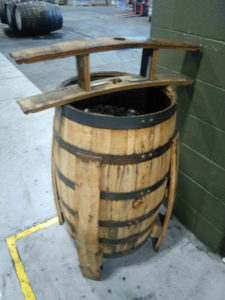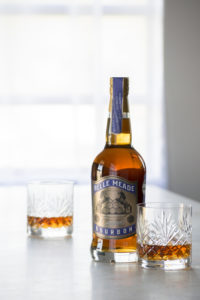The Renaissance Of Nelson’s Greenbrier
By Richard Thomas

(Credit: Richard Thomas)
A staple of the modern resurgence of American whiskey, and its attendant boom of bottling companies and small distilleries, is the story of a family reviving a moonshining or pre-Prohibition distilling tradition. Some of these tales are more authentic than others, and the cynicism that these tales are now met with is understandable. After all, nowadays it seems that everyone in America has a moonshing, bootlegging great grand-uncle.
The return of the Nelsons and the Greenbrier Distillery is one of the best of these stories, and not just because it is among the most authentic. It’s also because Tennessee’s Greenbrier Distillery was not some little outfit or illicit operator, but instead one of the pre-Prohibition big boys of Volunteer State whiskey-making.
From Grocers To Distillers
The Greenbrier story is quintessentially American, starting with the decision by John P. Nelson to sell the family candle and soap factory and immigrate from Germany to the U.S. in 1850. As the fairly plausible legend goes, the Nelson family capital was converted to gold, and sewn into John Nelson’s clothes. When he was swept overboard by an Atlantic gale, he sank like a stone. The Nelsons arrived in America nearly penniless, and with 15 year old Charlie Nelson and his brother responsible for their well-being.
They moved on to Cincinnati, just like many Germans arriving in the United States in the 1850s, and it was there that Charlie Nelson learned several trades bound up in the grocery business, such as butchery and the whiskey trade. Back in those days, the whiskey business was very much bound to the Ohio River, and with Cincinatti and Maysville as important as Louisville. It was a good place for a future distillery owner to cut his teeth.

(Credit: Richard Thomas)
Nelson then had that lucky stroke that has started many a successful business empire: being in the right place at the right time. Just before the Civil War, he moved to Nashville and started a grocery. Union forces occupied the city in late winter 1862, and the joint demands of occupying Tennessee and maintaining the Army of the Cumberland turned the Tennessee capital into the U.S. Army’s biggest supply base after Washington, D.C. itself. Trading in coffee, meat and whiskey, Charlie Nelson prospered.
The cornerstones of Nelson’s grocery business during the Civil War left marks that continue to this day. It was his blend of coffee that was served in Nashville’s Maxwell House Hotel, becoming Maxwell House Coffee. Nelson’s butcher went into business for himself, and that venture became H.G. Hill Food Stores, still operating in Nashville today. Nelson himself concentrated on the whiskey trade, buying the distillery that supplied him his whiskey, a distillery based in a town north of Nashville, Greenbrier.
The Greenbrier Distillery became one of Tennessee’s leading whiskey producers. In 1885, they sold about 380,000 gallons of whiskey. To put that into perspective, Old Taylor Distillery opened in Kentucky in 1887, and would soon become the first distillery in America to ship 1 million cases, or just shy of 1.2 million gallons. Greenbrier wasn’t the absolute biggest around, but it was hardly small fry either. In fact, it was probably the biggest producer in Tennessee at that time.
Charlie Nelson died in 1891, and his distillery only managed to outlive him by a generation. Tennessee enacted statewide Prohibition in 1909, several years before the ratification of the U.S. 18th Amendment, and Greenbrier was shuttered.

(Credit: Nelson’s Green Brier)
Nashville Renaissance
In the summer of 2006, Bill Nelson went up to Greenbrier with his sons, Andy and Charlie. Recalling family stories about the place, they set out to find the old distillery, a National Historic Register Site. The Nelson brothers were bit by the bug. Three years later, they started a company and revived the family brand. That was followed in 2013 by the launch of Belle Meade Bourbon, an MGP-sourced brand.
Belle Meade has since expanded to include finished expressions, such as the Cognac Finish and the 9 Year Old Sherry Cask. These bridged the gap as the Nelson’s opened their micro-distillery in Nashville’s Marathon Village complex in late 2014. That done, production began on their own Tennessee Whiskey, complete with the Lincoln County Process and informed by old Greenbrier wheated mash bills (yes, you read that right: wheated Tennessee Whiskey). Now Nelson’s Greenbrier is approaching it’s first in-house release.
When the new Greenbrier went operational, it soon laid down 108 30-gallon barrels. On July 4th, the Nelsons plan to release the yield of these barrels as “First 108” (Greenbrier has been closed for 108 years), divided into two 375ml lots: a Green Label blend bottled at 90 proof, and a single barrel, cask strength Gold Label.
First 108 is a one-time release. Nelson’s Greenbrier is producing nine barrels of whiskey per week on average, and all subsequent production after that first 108 barrels were barreled in standard 53-gallon ASBs. The next step is to release a projected four year old in 2019. But it’s with First 108 at the Nelson’s Greenbrier Renaissance will be complete, bringing the family and the brand back to Tennessee Whiskey.




